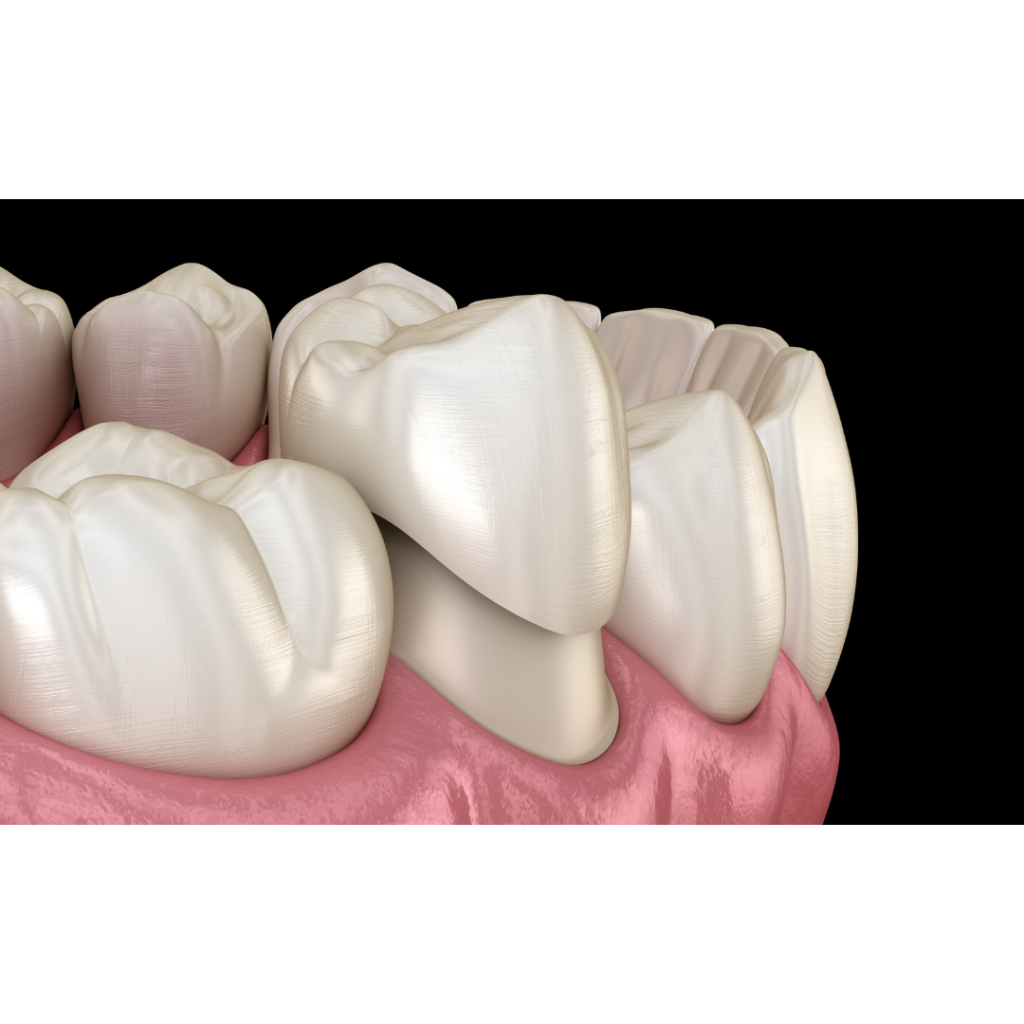Crowns

What are Dental Crowns?
Introduction
In the realm of restorative dentistry, dental crowns stand out as a pivotal solution for repairing and enhancing tooth structure. Whether due to decay, injury, or aesthetic purposes, dental crowns play a crucial role in restoring a tooth’s functionality and appearance. This article aims to shed light on what dental crowns are, their types, applications, and what patients can expect from the procedure.
Understanding Dental Crowns
A dental crown is a custom-fitted covering or “cap” that is placed over a tooth to restore its shape, size, strength, and appearance. When cemented into place, crowns fully encase the visible portion of a tooth that lies at and above the gum line.
Mountain View Pointe Dental's Complete Guide to Dental Crowns
The 6 Reasons for Need of Dental Crowns
Dental crowns are not just protective coverings; they play a multifaceted role in dental health and aesthetics. Let’s explore their applications in greater detail to understand the versatility of dental crowns in restorative dentistry.
1. Restoring a Broken or Worn Down Tooth
- Function Restoration: Teeth can become worn down from grinding, clenching, or general wear. Crowns restore the tooth to its optimal shape and size, enabling it to function properly for chewing and speaking.
- Structural Integrity: For teeth that are broken or chipped, crowns provide a covering to protect the remaining structure and prevent further damage.
2. Covering and Supporting a Tooth with a Large Filling
- Protection for Weak Structures: When a tooth has a large filling, especially after a significant cavity treatment, the remaining tooth structure may be weakened. A crown offers support and strength, ensuring the tooth can withstand the pressures of biting and chewing.
- Longevity: By encasing the tooth, the crown can prolong the life of a tooth that might otherwise be at risk of breaking.
3. Protecting a Weak Tooth from Breaking
- Reinforcement for Fragile Teeth: Teeth weakened by decay or with cracks are susceptible to further damage. A crown acts as a shield, providing much-needed strength to the tooth.
- Prevention of Tooth Loss: By reinforcing a weakened tooth, crowns can prevent a situation where tooth extraction might become necessary.
4. Anchoring a Dental Bridge
- Stability for Bridges: In the case of missing teeth, dental bridges require support. Crowns placed on the adjacent teeth provide this support, anchoring the bridge securely in place.
- Distributing Forces: These crowns help in evenly distributing the forces of biting and chewing, which is essential for the longevity and effectiveness of the bridge.
5. Covering a Dental Implant
- Final Restoration Phase: After a dental implant is placed, a crown is typically used to complete the restoration, acting as the visible part of the tooth.
- Aesthetics and Functionality: The crown on an implant looks and functions like a natural tooth, restoring both the aesthetics of the smile and the practical functionality of the tooth.
6. Cosmetic Enhancement
- Improving Dental Appearance: Crowns are an effective solution for teeth that are discolored, misshapen, or have gaps. They can be designed to match the size, shape, and color of natural teeth, enhancing the overall appearance of one’s smile.
- Confidence Boosting: For many, having a visually appealing smile is a significant confidence booster, and crowns can play a vital role in achieving this.
The Procedure of Getting a Dental Crown: A Detailed Walkthrough
The process of getting a dental crown is intricate and involves several key steps to ensure the best fit, function, and aesthetics. Below is a detailed look at each stage of the procedure.
1. Initial Examination
- Comprehensive Assessment: The dentist begins with a thorough examination of the affected tooth and surrounding structures. This includes checking for signs of decay, gum disease, and assessing overall oral health.
- X-Rays: X-rays are crucial to evaluate the roots of the tooth receiving the crown and the surrounding bone. This helps in identifying issues such as decay or infection that might be hidden below the gum line.
- Root Canal Consideration: If the tooth is found to be extensively decayed or infected, a root canal treatment may be necessary before proceeding with the crown. This treatment involves removing the infected or damaged pulp, cleaning the inside of the tooth, and sealing it to prevent further issues.
2. Tooth Preparation
- Reshaping: The tooth is reshaped by filing down along the top and sides to make space for the crown. This step is crucial as it ensures that the crown will fit properly and align correctly with your bite and adjacent teeth.
- Extent of Preparation: The amount of tooth structure removed depends on the type of crown being used. For instance, all-metal crowns might require less tooth structure removal than porcelain or porcelain-fused-to-metal crowns.
3. Impressions
- Creating a Mold: Once the tooth is reshaped, an impression of it, along with the surrounding teeth, is taken. This can be done with a putty-like material or digitally using advanced intraoral scanners.
- Custom Fabrication: The impression serves as a blueprint for the dental laboratory to fabricate the custom crown. This process ensures that the crown will fit seamlessly with your natural bite and adjacent teeth.
- Color Matching: The dentist also selects a shade for the crown that matches the color of your existing teeth for a natural appearance.
4. Temporary Crown
- Immediate Protection: While the permanent crown is being made, a temporary crown is placed over the prepared tooth. This crown is typically made of acrylic or a similar material and is cemented with temporary adhesive, allowing it to be easily removed later.
- Purpose: The temporary crown protects the prepared tooth, reduces sensitivity, and maintains the proper space in your bite for the permanent crown.
5. Final Fitting
- Permanent Crown Placement: Once your custom-made crown is ready, the dentist removes the temporary crown and cleans the tooth. The new crown is then tried on to ensure a perfect fit, correct bite, and appealing appearance.
- Adjustments: Any necessary adjustments are made at this stage. This might include trimming the crown or adjusting the color for a seamless blend with your natural teeth.
- Cementing: Once both you and the dentist are satisfied with the fit and look, the crown is cemented in place, completing the restoration.
Caring for Your Dental Crown: Ensuring Durability and Health
Proper care of your dental crown is crucial for its longevity and for maintaining overall oral health. Here’s a detailed guide on how to care for your dental crown effectively:
1. Oral Hygiene: The Cornerstone of Crown Care
- Brushing Regularly: Brush at least twice a day using a soft-bristled toothbrush. Be gentle around the crown to avoid dislodging it. Using toothpaste that is not overly abrasive can help maintain the crown’s surface.
- Flossing: Floss daily, paying special attention to the area around the crown. Slide the floss rather than snapping it between the teeth to avoid putting pressure on the crown.
- Regular Dental Check-Ups: Visit your dentist every six months or as recommended. These visits allow for professional cleaning of the crown and monitoring its condition and the health of the surrounding gum and teeth.
- Rinse with Mouthwash: Using an antibacterial mouthwash can help keep the area around the crown clean and free from harmful bacteria.
2. Avoiding Hard Foods: Preventing Physical Damage
- Chewing Habits: Avoid chewing hard foods like ice, hard candies, or nuts with your crowned tooth as it can cause chipping or even dislodging of the crown.
- Sticky Foods: Sticky foods can also be problematic as they can pull at the crown, potentially weakening its bond with the tooth.
- Temperature Sensitivity: Be cautious with very hot or cold foods and drinks as the crowned tooth might be sensitive to extreme temperatures.
3. Using Night Guards: Protecting Against Grinding
- Bruxism Protection: If you have a habit of grinding or clenching your teeth (bruxism), a night guard is essential. Grinding can put excessive pressure on the crown, leading to damage over time.
- Custom-Fitted Guards: Your dentist can provide you with a custom-fitted night guard that will protect both the crown and your natural teeth from the wear and tear caused by grinding.
4. Additional Tips for Crown Care
- Avoiding Harmful Habits: Habits like biting fingernails, chewing on pens, or using your teeth to open packaging can damage your dental crown.
- Monitor for Discomfort or Changes: If you experience discomfort, sensitivity, or notice changes in the fit or feel of the crown, contact your dentist. Early intervention can prevent more significant issues.

